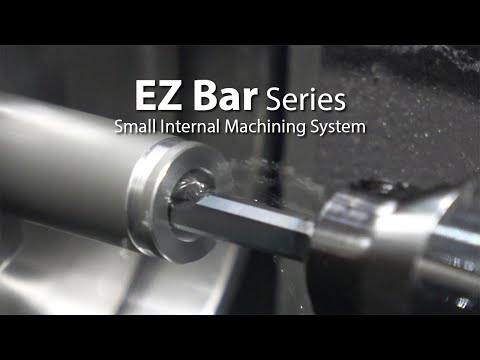Lights-Out Manufacturing: Kyocera Makes Microboring Possible
Kyocera’s EZ-Bar system for small-diameter machining counters common problems that can impede machine shop automation efforts.
Kyocera’s EZ-Bar system for small-diameter machining counters common problems that can impede machine shop automation efforts.
Lights-out machining is challenging to begin with.
Add high-strength alloys and complex workpieces with tight tolerance specifications into the mix and pulling off high-precision tasks like microboring without a machinist to watch for, and correct, any problems may seem virtually impossible.
It isn’t—if you have the right equipment.
The EZ-Bar system for small-diameter machining and PR1535 cutting inserts from Kyocera Precision Tools, for instance, help counter the challenges of machining stainless steels and other long-chipping materials in blind holes that might otherwise grind operations to a halt.
Without proper chip control and evacuation, chips can easily be packed into the workpiece during those types of jobs, breaking tools and even forcing machinists to scrap expensive parts.
One Kyocera customer, a small-parts manufacturer that produces high-precision parts from high-strength metals, has used Kyocera cutting tools in tandem with specialized programming to run lights-out operations more than 150 hours a week.
That company, like others across the manufacturing industry, made the move to adapt to a worker shortage that may widen to 2.1 million by 2030, compounding the challenges of supply-chain disruption, high inflation and rising interest rates.

Powered in part by the industrial internet and advancing robotics, lights-out manufacturing has surged in popularity in recent years, though The Association For Manufacturing Technology says many companies will find it more realistic to automate a select portion of their operations rather than all of them.
“Fully automating a plant is only cost-effective for a large production volume over a long period of time,” according to the organization. “This is because designing a lights-out manufacturing process is a complex, resource-intensive process which requires detailed upfront planning in process development and validation as well as the setup and management of probing routines, robots and grippers, remote monitoring systems, and machine and tool maintenance.”
Even the automation of individual operations can be complex for a machine shop.
As the intricacy of a workpiece increases, shop owners need equipment that produces consistent results to develop automation plans that account accurately for operational dynamics. Frequently, they have to invest in additional machine tool accessories to achieve their goals.

Kyocera became the go-to supplier of cutting tools for its precision parts-making customer, for instance, because of the consistency of its tools and the chip control they enabled.
“The EZ-Bar’s replacement repeatability is far superior to other systems on the market,” the company’s owner explains. “All EZ-Bars have a unique ground angle which interfaces with an adjustable pin in the holder to control projection length.”
Controlling the length can significantly reduce radial deviation and vibration, which are “critical for consistency when you’re working with tight tolerances and have to hold tenths of an inch,” the owner adds.
Used in industries from medical equipment to aerospace, the EZ-Bar delivers flexibility partly because of its variety of sleeve options, one of which includes through-pipes for coolants used in some types of machining. The tool also comes with either standard or high-precision bars.
Read More: How Kyocera’s EZ-Bar System Boosts Productivity
Many users have been particularly pleased with the EZ-Bar’s versatility, noting how easily it can be applied to tasks beyond straight boring, says Steve Easterday, Swiss applications engineer for Kyocera.
“ID groove, face groove, profile, threading, etc. are common, especially in aerospace applications,” he explains. “The simplicity of changing out the insert bars for these features provides ease and faster setup with minimal or no centerline adjustment.”
The design of the EZ-Bar’s sleeves shortens setup time dramatically because the overhang of the cutting bars inserted into them can be altered by sliding the system’s adjusting pins into built-in slots.
Not only do the pins eliminate the need to use rulers for fine-tuning tool length, they also serve the additional purpose of preventing bar rotation during use, an advantage over conventional sleeves that rely solely on positioning screws inserted from above.
That guarantees high repeatability, or avoidance of deviations between parts machined on the same run, helping shops attempting any lights-out operation to counter some of the challenges that Forbes magazine says have historically thwarted automation initiatives.
“There’s a misperception that manufacturing work is dull and repetitive,” the magazine noted in a post. “In reality, manual assembly requires an enormous amount of individual skill. Modern manufacturing lines can require decision-making and sensitivity that’s hard to replicate with algorithms and robots.”
In machining, that’s evident with cut-off operations, which are a close second to microboring when it comes to automation hurdles.
Poor chip control can cause scratches on parts, entanglement with other tools, or in a worst-case scenario, chipping and failure of the cut-off tool.
Kyocera’s KGD system for small and medium-size part-off and grooving has been one of the supplier’s most popular products for users tackling such challenges.
“Pairing together grade PR1535 inserts with a very free-cutting chipbreaker like the PM allows for good chip formation in a variety of materials,” says Jacob Cutler, regional sales manager for Kyocera. “When we can control these two factors, it allows for a very stable process.”




